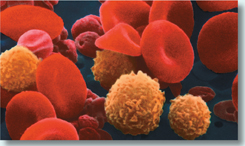33 Study Guide
 Structure and Function
Structure and Function
The functions of the circulatory and respiratory systems are closely connected. Without the circulatory system, oxygen could not be transported from the lungs to the rest of the body. Without the respiratory system, the powerful cardiac muscles would not receive the oxygen they need to drive the circulatory system.
33.1 The Circulatory System
 The circulatory system transports oxygen, nutrients, and other substances throughout the body, and removes wastes from tissues.
The circulatory system transports oxygen, nutrients, and other substances throughout the body, and removes wastes from tissues.
 Powerful contractions of the myocardium pump blood through the circulatory system.
Powerful contractions of the myocardium pump blood through the circulatory system.
 As blood flows through the circulatory system, it moves through three types of blood vessels—arteries, capillaries, and veins.
As blood flows through the circulatory system, it moves through three types of blood vessels—arteries, capillaries, and veins.
33.2 Blood and the Lymphatic System
 Plasma is about 90 percent water and 10 percent dissolved gases, salts, nutrients, enzymes, hormones, waste products, plasma proteins, cholesterol, and other important compounds.
Plasma is about 90 percent water and 10 percent dissolved gases, salts, nutrients, enzymes, hormones, waste products, plasma proteins, cholesterol, and other important compounds.
 The main function of red blood cells is to transport oxygen.
The main function of red blood cells is to transport oxygen.
 White blood cells guard against infection, fight parasites, and attack bacteria.
White blood cells guard against infection, fight parasites, and attack bacteria.
 Blood clotting is made possible by plasma proteins and cell fragments called platelets.
Blood clotting is made possible by plasma proteins and cell fragments called platelets.
 The lymphatic system is a network of vessels, nodes, and organs that collects the lymph that leaves capillaries, “screens” it for microorganisms, and returns it to the circulatory system.
The lymphatic system is a network of vessels, nodes, and organs that collects the lymph that leaves capillaries, “screens” it for microorganisms, and returns it to the circulatory system.
 Three common and serious diseases of the circulatory system are heart disease, stroke, and high blood pressure.
Three common and serious diseases of the circulatory system are heart disease, stroke, and high blood pressure.
 Research indicates that high cholesterol levels, along with other risk factors, lead to atherosclerosis and higher risk of heart attack.
Research indicates that high cholesterol levels, along with other risk factors, lead to atherosclerosis and higher risk of heart attack.
plasma (954)
platelet (955)
red blood cell (954)
lymph (956)
hemoglobin (954)
atherosclerosis (958)
white blood cell (955)

33.3 The Respiratory System
 The human respiratory system picks up oxygen from the air we inhale and releases carbon dioxide into the air we exhale.
The human respiratory system picks up oxygen from the air we inhale and releases carbon dioxide into the air we exhale.
 Oxygen and carbon dioxide are exchanged across the walls of alveoli and capillaries. Chemical properties of blood and red blood cells allow for efficient transport of gases throughout the body.
Oxygen and carbon dioxide are exchanged across the walls of alveoli and capillaries. Chemical properties of blood and red blood cells allow for efficient transport of gases throughout the body.
 Movements of the diaphragm and rib cage change air pressure in the chest cavity during inhalation and exhalation.
Movements of the diaphragm and rib cage change air pressure in the chest cavity during inhalation and exhalation.
 Chemicals in tobacco smoke damage structures throughout the respiratory system and have other negative health effects, too.
Chemicals in tobacco smoke damage structures throughout the respiratory system and have other negative health effects, too.
Think Visually Make a two-column table. Title the first column Structure and the second column Function. Fill in the table with the structures described in this chapter—from both circulatory and respiratory systems—and their functions.

Table of Contents
- Formulas and Equations
- Applying Formulas and Equations
- Mean, Median, and Mode
- Estimation
- Using Measurements in Calculations
- Effects of Measurement Errors
- Accuracy
- Precision
- Comparing Accuracy and Precision
- Significant Figures
- Calculating With Significant Figures
- Scientific Notation
- Calculating With Scientific Notation
- Dimensional Analysis
- Applying Dimensional Analysis




